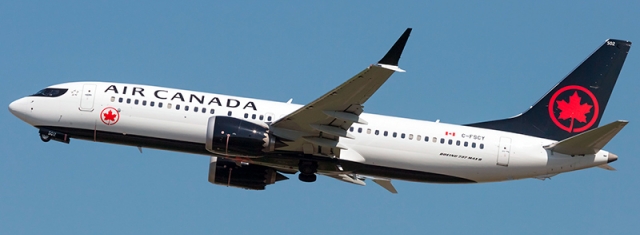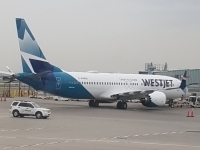Travel
Boeing 737 MAX 8 Remans Grounded
Air Canada And Westjet Respond

Air Canada Boeing 737 MAX 8 (Source: Brian Teepell)
USPA NEWS -
After the latest statement from Boeing, Canada's two largest airlines Westjet and Air Canada have removed the Boeing 737 Max 8 from their schedules until June as the grounding of the troubled aircraft is going to last into the busy summer travel season.
As previously reported in March of 2019, following in the footsteps of the International Community, on March 13th, Marc Garneau the Transport Minister of Canada banned the Boeing 737 Max 8 planes from use in Canadian Airspace. At the time Westjet had 13 Max 8 aircraft and Air Canada had 24 Max 8 aircraft that were grounded. The ban followed the crash of Ethiopian Airlines Flight 302 on March 10th, 2019 and the Lion Air crash in October of 2018. Both fatal crashes involved the 737 Max 8 killing nearly 350 people. These two terrible tragedies certainly raise the safety integrity of this aircraft which definitely warrants investigation with the hope of avoiding such events in the future. It is not clear how long this ban will be in place, but some speculate August or beyond.
In April of 2019 based on that information, Air Canada and Westjet were forced to make the following operational adjustments: Westjet's Chief Operating Officer, Jeff Martin, posted the following statement to their website. "Westjet has adjusted flight times on some routes or substituted larger aircraft with fewer flights, but it needed to suspend a small number of routes where no alternative aircraft were available. Although the Max comprised over 1,000 monthly departures in our June schedules, by adjusting our aircraft lease returns and the planned installations of our premium seats, we have been able to cover more than 700 of the flight routes where the Max was originally scheduled, with other aircraft. I thank our WestJet teams for their dedication as they continue to work hard to get our guests to their destinations." Martin goes on to say "Westjet remains committed to the routes and will resume flights when it can. Westjet advised of the following changes "Flights between Halifax and Paris have been suspended from June 3 through Aug. 2, and WestJet say guests will be rebooked either through Calgary, non-stop on its Boeing Dreamliner jets to Paris, or with one of its partner airlines through Toronto, Montreal or New York. Flights between Edmonton and Ottawa, and Edmonton and Montreal, have also been suspended for most of June, and WestJet says guests will be rebooked through either Calgary or Toronto on WestJet operated flights. Service between Toronto and Kelowna, B.C., and Vancouver and Regina will also be suspended for much of June." At that time there was no way to know that the grounding would last into 2020.
On January 21, 2020, Boeing released the following statement, "We are informing our customers and suppliers that we are currently estimating that the ungrounding of the 737 MAX will begin during mid-2020. This updated estimate is informed by our experience to date with the certification process. It is subject to our ongoing attempts to address known schedule risks and further developments that may arise in connection with the certification process. It also accounts for the rigorous scrutiny that regulatory authorities are rightly applying at every step of their review of the 737 MAX´s flight control system and the Joint Operations Evaluation Board process which determines pilot training requirements. Returning the MAX safely to service is our number one priority, and we are confident that will happen."
Up until this current statement, Westjet and Air Canada had scheduled some flights using the 737 Max 8 based on the earlier predicted lift of the grounding by March 31, 2020. Now with the latest estimated date of June 30th, both airlines are forced to remove the Max from flight schedule until that time.
Liability for this article lies with the author, who also holds the copyright. Editorial content from USPA may be quoted on other websites as long as the quote comprises no more than 5% of the entire text, is marked as such and the source is named (via hyperlink).






